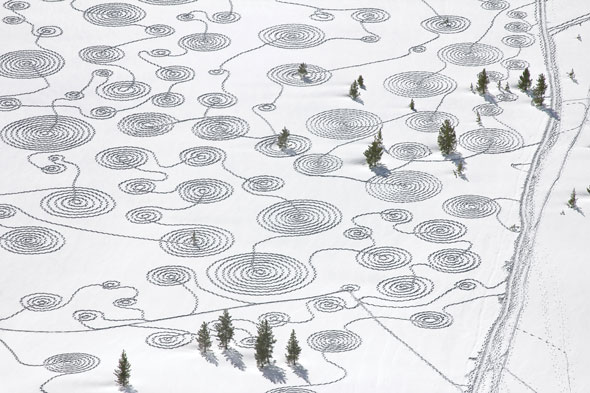Text by Emilie Trice

German artist Sonja Hinrichsen’s epic environmental installations manifest more than the natural beauty of her chosen canvas. They are exercises in meditation, philosophically tied to the native tribes of America’s vast landscape, their symbols, rituals and mythologies. Best known for her series of “Snow Drawings,” Hinrichsen creates ephemeral compositions that eschew the trappings of contemporary art’s obsession with materialism. Her documentation of these pieces, which include photos and videos, are the only objects that substantiate her practice beyond each piece’s finite lifecycle. As with Andy Goldsworthy, her installations will eventually recede into the landscape, indistinguishable from their origins.
Hinrichsen first came to America as a 19-year-old high school graduate, traveling cross-country by Greyhound bus from the East to the West coast and back again. Her impressions of America focused on the expansive openness of the landscape, in contrast to the dense population of her native Europe. “I was taken by the environment here from the beginning and that still informs my work,” she says. Hinrichsen later returned to America for graduate school and settled in the Bay Area in 2005. However, Hinrichsen would best be described as nomadic, constantly moving from residency to residency, developing works on site that respond directly to her adopted surroundings.
The “Snow Drawings” that Hinrichsen created at Rabbit Ears Pass near Steamboat Springs, CO were executed with the assistance of a group of volunteers on snowshoes. The repetition of a simple pattern, performed communally, connects this work to the ritualized practices of Native American tribes, whose culture and spirituality Hinrichsen cites as a central influence to her work.
Many of Hinrichsen’s artworks incorporate Native American symbolism, especially the spiral, a form that has universal significance, but is commonly found in Native American tribal art. The Hopi’s use of the spiral represents journeys made to the far reaches of the earth and beyond, into the ‘Otherworld.’ When viewing Hinrichsen’s “Snow Drawings,” their incredibly poetic simplicity seems to radiate a kind of mysticism, a sublime path drawn across nature’s quiet canvas. In another work, “Sun/Moon Symbol,” Hinrichsen created forms out of rocks that she coated in a phosphorescent powder. The rocks absorbed sunlight during the day and reflected that energy in the night, becoming glowing references to the celestial worship of archaic tribes.
Still, Hinrichsen’s work extends beyond environmental interventions; the artist also confronts urban settings and their sociological narratives. She interviews residents, mapping their histories with ethnographic detail and intertwines her research with imagery sourced from both past and present. The resulting installations often combine large-scale video projections with audio and sculptural elements, creating multi-media environments that seek to translate the hidden identities of collective spaces.
In one such project, entitled “Bridging” (2005), Hinrichsen spent four months recording images of pedestrians crossing the Mária Valéria Bridge, which connects Hungary and Slovakia across the Danube River. The bridge dates back to 1895, but was destroyed during World War II and only fully-restored in 2001, when the Danube was established as the new geographic border between the two countries, despite the two towns on either side of the bridge both being Hungarian before the war. Due to the political situation, communication between citizens on either side of the bridge was repressed, creating isolation where there had once been community. Hinrichsen interviewed residents of both towns, archiving their memories of the years before the war, during the separation and following the restoration of the bridge, which were projected as text among slides of the bridge as it stands today, a functioning conduit between formerly divided people, who share a common past.
All of Hinrichsen’s works, whether land art or urban studies, employ community outreach and education. Her artistic practice is exceptionally non-commercial—a romantic, even altruistic ideal of what an artist should be—that in today’s commodity-driven and profit-obsessed times few artists actually are. Hinrichsen creates work that is both informative and mystifying, methodical and magical. She writes that, “I am not interested in creating lasting art pieces, as I believe that our world is over-saturated with man-made products.” She would rather “inspire appreciation and awe for our natural world.” Like the Native American tribes whose customs fascinate her, Hinrichsen orchestrates a symbolic relationship between the beauty of nature and the evolution of humanity.
Her art speaks of the transience that defines our everyday lives, but rejoices in the wonders of the universe that transcend our earthly existence.

